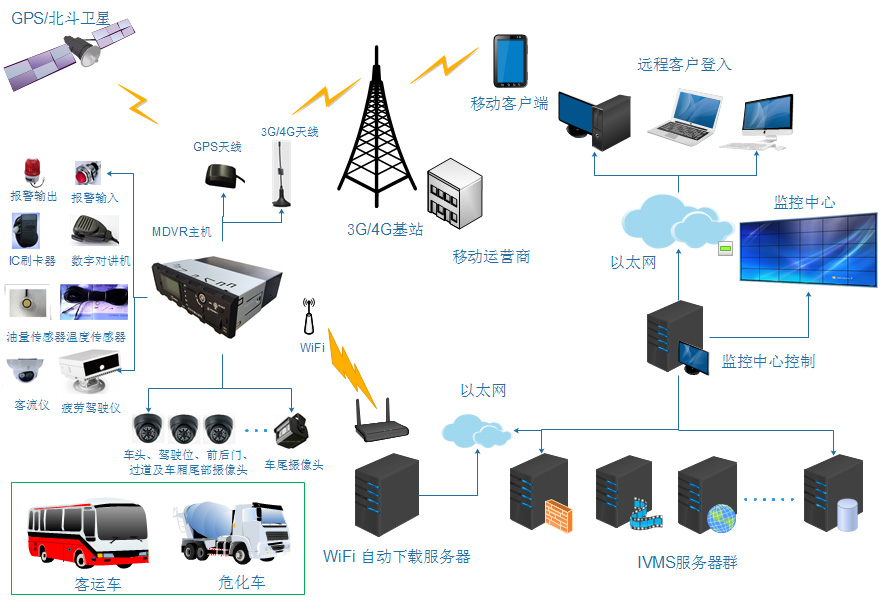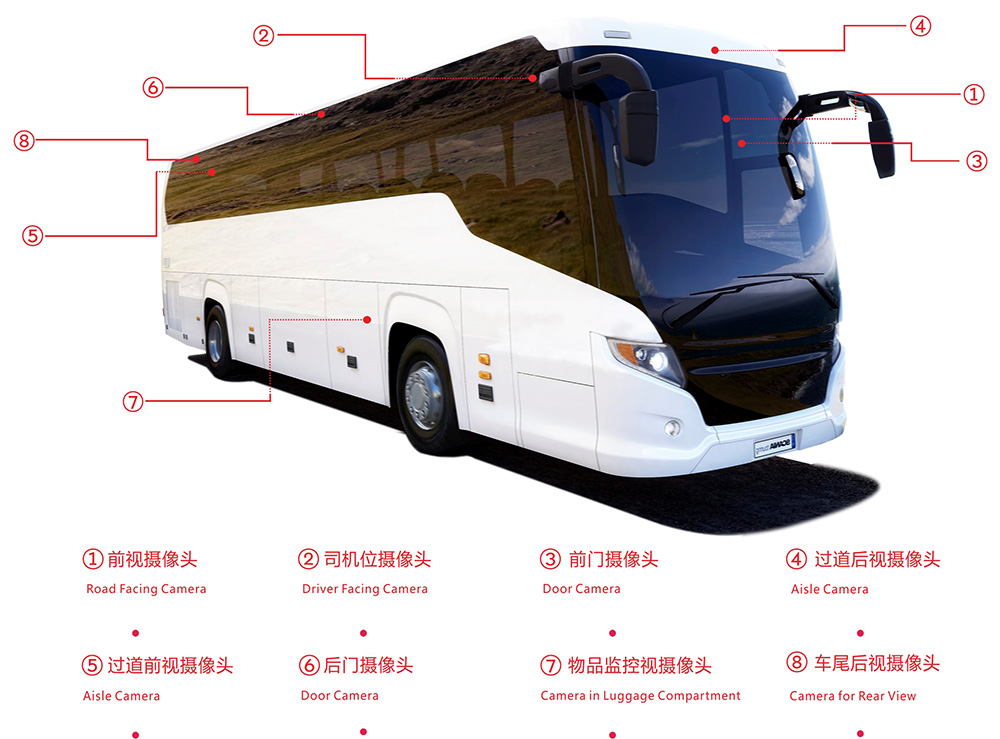
With the rapid development of the urban economy, the exchanges between cities are becoming more frequent, the number of long-distance passenger transport lines between cities is constantly increasing, the number of vehicles is increasing, and the scale of stations is constantly increasing. Long-distance passenger vehicles are densely populated and enclosed places, which are prone to overloading, privately carrying passengers, corruption of fares, transportation/passenger disputes; security incidents such as theft and robbery often occur during night driving; Major traffic accidents caused by illegal operations such as telephone calls and fatigue driving have also occurred from time to time... These undoubtedly seriously affect the normal operation of passenger transport companies, and cause great troubles to the management and dispatch of the fleet. Long-distance passenger vehicles urgently need to install on-board real-time monitoring systems to get out of the current predicament.
With the continuous development of the urban economy and the continuous expansion of the scope, passenger transport companies will also move towards rapid development. As the policy level pays more and more attention to public transportation safety, as a passenger transport company manager, you will definitely consider the safety of passenger transport while considering development. So are you worrying about the following questions?
1) Although passenger vehicles are equipped with GPS positioning systems, which can realize vehicle navigation and dispatch, the safety of passengers’ property cannot be guaranteed, especially when driving at night, security incidents such as theft, robbery, disputes, and fights are prone to occur. Inability to provide strong evidence;
2) Drivers' operating specifications, unsupervised vehicle driving routes, speeding, fatigue driving, traffic violations, driving and making phone calls and other bad behaviors have increased the potential safety hazards in the transportation process;
3) After leaving the station, the driver embezzles the fare, causing overloading and fines; driver and passenger collude to seek benefits, change the route without authorization, and other violations, which can easily cause complaints/contradictions from passengers, and also affect the image of the company;
4) It is difficult for the management center to obtain accurate operation data due to scattered management, and it is impossible to conduct effective assessment of drivers. The false reports and false reports of drivers cannot be contained, which leads to increased operating costs;
5) In case of traffic accidents, robberies, vehicle breakdowns, traffic jams and other emergencies during transportation, the monitoring center cannot respond in a timely manner, resulting in failure to arrive on time, which is likely to cause complaints from passengers;
6) The society has continuously improved the service quality requirements of passenger transport companies, and only by continuously improving their own service levels can they win in the market competition.
3. The composition of the on-board monitoring system for passenger vehicles
At present, in view of the frequent occurrence of long-distance passenger vehicle traffic accidents and the increasing social impact, passenger transport companies are also eager to strengthen the supervision of vehicles under their jurisdiction. At the same time, relevant government departments are gradually introducing corresponding measures to strengthen supervision. For example, on April 11, 2011, the Ministry of Communications issued the "Notice on the earnest implementation of the two standards: "Technical Requirements for Road Transport Vehicle Satellite Positioning System Platforms" and "Road Transport Vehicle Satellite Positioning System Technical Requirements for Vehicle Terminals".
With years of experience in research and development of on-board monitoring products, Tianyude actively responds to the needs of the passenger transportation on-board monitoring industry market and launches 3G/4G on-board intelligent monitoring system solutions to solve the problems faced by managers of long-distance passenger transportation companies.
The system completes the encoding and storage of audio, video, GPS, and alarm data through the MDVR host. And through the 3G/4G mobile network to complete the upload of audio and video, alarm information, GPS data; at the same time to achieve remote equipment upgrades, parameter modification, digital intercom, remote capture and other remote management operations.
Managers of the server monitoring center only need to authorize the corresponding vehicles through the server background software, and generate the corresponding account numbers and passwords to perform unified management. At the same time, other accounts can also be created through the web client for other personnel to view and manage in real time on smart phones and computers.

The 3G/4G vehicle intelligent monitoring system includes the front-end vehicle monitoring system, mobile communication network, and server monitoring center. Based on the design principles of advancement, practicability, scalability, reliability, safety, and ease of use; established with the tenet of systematization, flexibility, high efficiency, and stability.
A: Front-end vehicle monitoring system
The front-end on-board monitoring system is an important part of the entire program. It collects audio and video data by installing cameras inside and outside the vehicle to achieve safe and dead-angle monitoring; and uses GPS global satellite positioning system to achieve real-time positioning of the vehicle. At the same time, an external vehicle alarm switch (such as: alarm button, brake, door sensor switch, etc.), equipped with a digital intercom can realize one-to-one or one-to-many intercom between the platform and the device; the installation of a fatigue driving device can prevent the driver from driving fatigue and avoid occurrence Traffic accidents; installation of temperature sensors can provide passengers with information on the temperature difference between indoor and outdoor. And through the vehicle-mounted MDVR host to encode and store audio, video, GPS, and alarm data, and 3G/4G wireless network reporting to the server, so as to realize the remote monitoring and management of the vehicle.
Camera installation location:
1) Front-view camera at the front of the car: the function of the driving recorder;
2) Driving position camera: standardize operation and operation;
3) Front door camera: monitor passengers getting on the bus;
4) Aisle front-view camera: no blind spot monitoring to prevent pickpockets in the car;
5) Aisle rear view camera: no blind spot monitoring, to prevent pickpockets in the car;
6) Rear door camera: monitor passengers getting off the bus;
7) Front-view camera in the rear compartment: no blind spot monitoring, lost property inquiry, and prevention of pickpockets in the car;
8) Rear view camera at the rear of the car: monitoring the road conditions behind the car

B: Mobile communication network
Since the monitoring points of the front-end vehicle monitoring system are in a constantly moving environment, audio and video, GPS, passenger flow statistics and alarm data can only be transmitted through the 3G/4G mobile network. At the same time, remote management operations such as equipment remote upgrade, equipment parameter modification, digital intercom and alarm information viewing can also be completed through the 3G/4G mobile network.
C: Server Monitoring Center
The server monitoring center is a remote monitoring and management center composed of IVMS server group, background management software and client software. It adopts a centralized and distributed network management architecture, which can realize remote real-time monitoring, recording, and capturing of multiple vehicles at the same time; Video search, download, analysis and playback; combined with GIS electronic map to view the distribution status of vehicles; query driving trajectory and playback; view alarm information, quickly locate the geographic location and live video of the alarm vehicle. At the same time, a WiFi automatic download server is configured in the parking lot of the bus terminal, which can automatically download surveillance video files to the server designated by each fleet for storage.
Managers of the server monitoring center only need to authorize the corresponding vehicles through the server background software, and generate the corresponding account numbers and passwords to perform unified management. At the same time, other accounts can also be created through the web client for other personnel to view and manage in real time on smart phones and computers.

Shenzhen Tianyude Technology Co., Ltd.
Address: 202, Block B, Building C14, Fuyuan Industrial City, Zhoushi Road, Bao'an District, Shenzhen
Technical support: Mr. Lei 15019453604
Phone: 0755-29470519
Fax: 0755-29185700
URL:www.tydvideo.com
